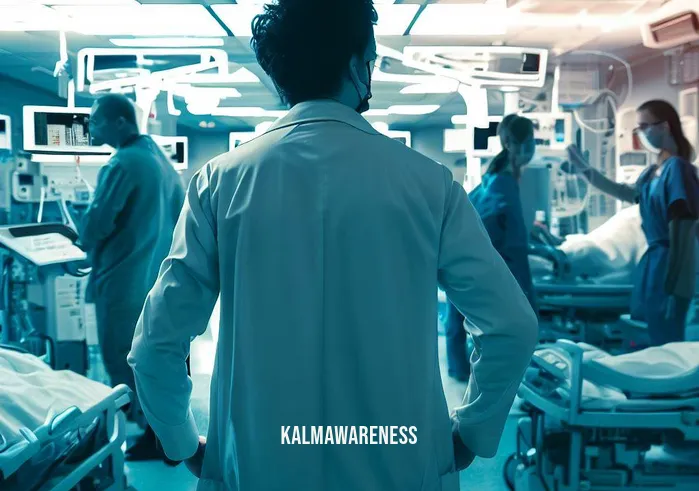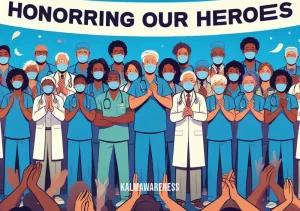The Transformative Power of Doctor’s Meditation in Stress Management and Well-being
As someone entrenched in the medical profession, the constant balancing act between saving lives and maintaining your own well-being can be daunting. The power of doctor’s meditation is an underexplored domain that could drastically change this narrative. In the healthcare environment, a physician’s emotional and physical health directly impacts patient care, and yet, there’s a noticeable void when it comes to proactive measures for physicians’ well-being. In this series, we will delve deeper into how meditation can be the cornerstone of stress management, physician well-being, and mind-body health.
The Overlooked Crisis in Physician Well-being
Doctors are considered paragons of health and well-being. Ironically, they are often at higher risk for burnout, stress, and even suicide. The underlying issue is not just the workload but also the emotional burden and constant pressure they bear. Brussels Mindfulness Work suggests that mindfulness techniques can offer an oasis of peace amid chaos, providing an essential coping mechanism.
The Mechanism of Stress: Knowing the Enemy
Understanding stress in the medical profession requires defining what constitutes a stressor and what escalates into a crisis. A stressor and a crisis can manifest in various forms, from demanding work hours to the emotional toll of patient care. Knowing how to differentiate between the two allows for more effective stress management strategies.
The Symbiosis of Mind-Body Health
Medical science often focuses on the body, sometimes neglecting the profound effect the mind has on physical health. It’s your own body and mind, and the symbiosis between the two can’t be overstated. When the mind suffers, the body can’t be far behind, and for physicians, this leads to a cycle of stress and fatigue, adversely affecting their practice and patient care.
“The harmony between mind and body is the key to a fulfilling and effective medical practice.”
The Toolbox: Mindfulness Techniques for Physicians
Various meditation techniques can aid doctors in achieving peace and focus in their high-pressure roles. Guided imagery in nursing has demonstrated significant success, and similar practices can be beneficial for physicians as well.
- Breathing Exercises: Sometimes, you need to remember just to breathe. Deep, mindful breathing can serve as an immediate stress alleviator.
- Pace Yourself: As a doctor, learn to pace yourself to prevent burnout.
- Task Shifting: In mental health, task-shifting can be employed to delegate tasks and focus on essential duties.
- Smiling Mind: Incorporating Smiling Mind Corporate techniques to induce a state of calm.
How to Get Started with Doctor’s Meditation
If you’re intrigued by the transformative potential of doctor’s meditation, a Be Calm Book can be your first step towards integrating these practices into your daily life. From enhancing your ability to keep cool under pressure to addressing whatever is bothering you, the benefits are manifold.
As we delve deeper into the complexities of doctor’s meditation in the next segments, we will explore how to implement these tools effectively in your daily routine to yield sustainable results.
For those who find it challenging to detach from the digital world, fret not. We will also discuss mindful software and mindful therapy solutions tailored for the busy healthcare professional in the upcoming chapter.
The road to achieving a balanced life as a healthcare provider may be fraught with challenges, but as the old saying goes, “The journey of a thousand miles begins with a single step.”
Let’s take that step together in the next chapter.
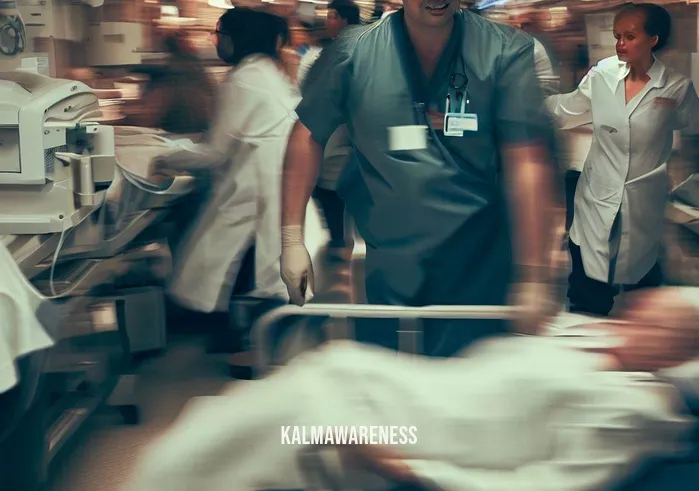
Navigating the Nuances of Doctor’s Meditation: Beyond the Basics
In the introductory segment, we briefly touched upon the burgeoning field of doctor’s meditation. As we dive deeper into the subject, let’s expand our understanding of its complexities and potential. Here, we will unpack various facets of doctor’s meditation, including its types, benefits, and even technological resources that can make this journey smoother for healthcare providers.
The Importance of Specialized Meditation for Doctors
Doctor’s meditation isn’t a one-size-fits-all solution borrowed from conventional mindfulness practices. Instead, it is tailored to meet the unique stressors and pressures of the medical field. It aims to provide the necessary emotional and mental fortitude that helps healthcare providers function at their best. Physicians who regularly practice meditation techniques designed for their specific challenges have been found to be more resilient and efficient. Understanding the concept of task shifting in mental health reveals how changing our focus can have profound effects on stress management.
Types of Doctor’s Meditation: A Handy Guide
Understanding the different types of meditation can be quite beneficial for healthcare providers. Here is a table summarizing the popular styles of doctor’s meditation:
| Type of Meditation | Core Element | Specific Benefits for Doctors |
|---|---|---|
| Mindful Breathing | Focus on breath | Decreases stress, improves focus |
| Guided Imagery | Mental visualization | Enhances problem-solving skills |
| Body Scan | Awareness of bodily sensations | Reduces physical fatigue |
| Compassion Meditation | Focus on positive emotions | Improves patient interaction |
| Transcendental Meditation | Repetition of mantra | Enhances decision-making |
To further assist, there are specialized resources like Mindful Therapy Commack and Mindfulness for Young Adults that offer bespoke meditation courses.
Integrating Meditation into Daily Life
The effectiveness of any meditation technique lies in its regular practice. Here are some ways to incorporate it into your daily life:
- Morning Ritual: Starting your day with just 5 minutes of The Doctor’s Meditation can set a positive tone.
- Scheduled Breaks: Take short meditation breaks. It’s not about finding the time but making it.
- Technology Aids: Use Mindful Software designed to remind you to take meditation breaks.
- End-of-day Reflection: Just before leaving the workplace, take a moment to reflect and relax. This can be your personal time to ‘reset.’
Moving Towards a Mindful Practice
One of the common misconceptions about meditation is the amount of time it requires. Interestingly, even a few minutes can offer significant benefits, such as helping you not get flustered easily. The key lies in consistency.
- The principle of holding up, taking a moment, and counting can offer an immediate escape from acute stress situations.
- Techniques like guided imagery in nursing can be adapted for doctors to develop emotional resilience.
- There’s a subtle difference between surviving and thriving. Employing methods to pace yourself ensures that you belong to the latter category.
“Meditation is not about avoiding the battle of life; it’s about embracing it with more mindfulness and calm.”
What Awaits in the Next Chapter?
You’ve now gained an expansive understanding of the multifaceted nature of doctor’s meditation. But understanding is just the first step; application brings about transformation. In the next chapter, we’ll look into actionable steps and programs specifically designed for healthcare providers to reap the rewards of a meditative practice.
Are you interested in discovering how to kick-start your personal meditation journey or perhaps implementing a mindfulness program in your healthcare setting? Continue reading to find out.
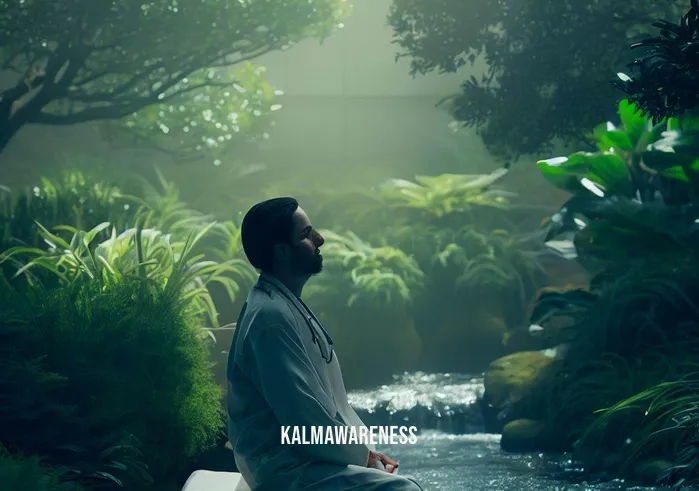
The Heart of the Matter: Finding Hope Through Doctor’s Meditation
The journey to understanding doctor’s meditation is like peeling an onion; each layer we remove reveals something more profound and essential. Having explored its complexities and methodologies in the earlier chapters, let’s now focus on the inspiration that it offers. How do physicians find hope and strength through meditative practices? And what is the significance of these practices in their lives?
The Transformative Power of Doctor’s Meditation
Why should physicians resort to doctor-centric mindfulness practices? The answer is both complex and straightforward. With mounting stress and rapidly increasing burnout rates among doctors, it’s imperative to adopt strategies that provide more than just momentary relief. Understanding the difference between a stressor and a crisis can offer deeper insights into how doctor’s meditation—also known as clinician’s mindfulness—provides a longer-term solution.
“You cannot swim for new horizons until you have courage to lose sight of the shore.” – William Faulkner
Voices of Hope: Real Stories of Transformation
When it comes to drawing inspiration, nothing beats real stories from real people. Physicians around the globe have shared testimonies about how they’ve turned their lives around, thanks to meditation.
- Firsthand Experience: A seasoned practitioner talks about how she learned to breathe properly, emphasizing how doctor’s meditation helped her manage workload stress.
- Shared Practices: A group of resident doctors describe how incorporating smiling mind corporate techniques into their routines improved patient care.
- Community Inspiration: The story of a medical unit that transformed its workplace culture through mindful therapy solutions.
“Hope is the physician of each misery.” – Irish Proverb
Strategies for Incorporating Hope into Daily Practices
Hope is not just an abstract concept; it can be an integral part of a clinician’s daily routine. Here are some actionable steps:
- Daily Affirmations: A simple mantra or affirmation can set a positive tone for the day. Check out Be Calm Book for a collection of empowering affirmations.
- Journaling: Reflecting on your daily experiences can be therapeutic. Note down instances that made you feel hopeful or happy.
- Peer Inspiration: Create a support group within your healthcare facility to discuss issues openly. Use techniques like Brussels mindfulness work to instill hope.
“Hope and fear cannot occupy the same space. Invite one to stay.” – Maya Angelou
The Journey Ahead: Beyond Hope
We’ve seen the profound impact that doctor’s meditation can have not just on stress management, but also on instilling a sense of hope and inspiration among clinicians. It offers a robust mechanism for maintaining composure under pressure and ensuring better physician well-being.
“Hope is being able to see that there is light despite all of the darkness.” – Desmond Tutu
As we advance in our understanding, it becomes apparent that these meditative practices are more than just coping mechanisms; they are life-changing tools.
What’s Next?
So far, we’ve delved into the science, methods, and the inspirational aspects of doctor’s meditation. In the next chapter, we’ll explore how to build a sustainable practice. Interested in taking your mindfulness skills to the next level? What about bringing transformative changes to your healthcare facility through meditation? Keep reading to unveil the blueprint for implementing a robust, impactful doctor’s meditation program in your life and practice.
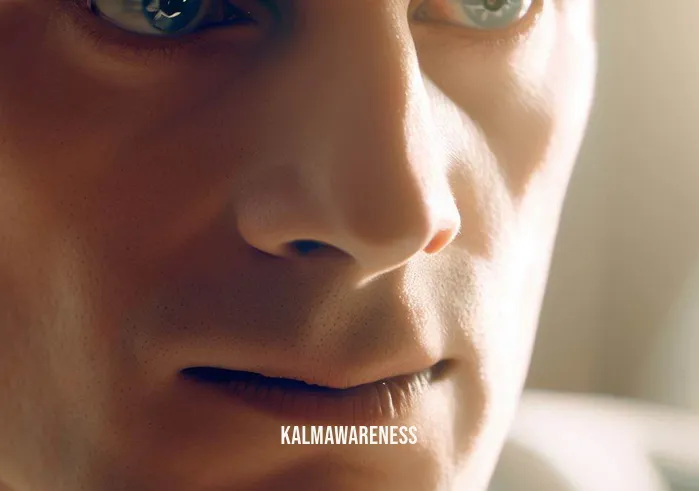
The Anatomy of Calm: Breaking Down Doctor’s Meditation
As we edge closer to a comprehensive understanding of doctor’s meditation, also known as physician mindfulness, it’s important to break down its elements. In the realm of medical practice, details matter. The same applies to the intricacies of meditation and how it specifically caters to doctors. In this chapter, we will delve into the nuts and bolts of doctor’s meditation, dissecting its different components for an in-depth understanding.
Types of Meditation Suitable for Doctors
Doctor’s meditation isn’t a one-size-fits-all approach; it comprises various techniques that address distinct needs and preferences. If you’re a doctor struggling to not get flustered easily, there is a form of meditation just for you. Here are some types worth considering:
- Mindfulness Meditation: Helps in grounding the practitioner in the present moment.
- Transcendental Meditation: Ideal for those who prefer mantra-based techniques.
- Guided Imagery: Particularly beneficial for medical professionals, especially those involved in nursing.
- Body Scan Meditation: Focuses on a systematic scan of body parts, encouraging a mind-body connection.
Core Components of Doctor’s Meditation
Understanding the core elements of doctor’s meditation can provide valuable insights into how it can be a difficult thing to maintain under pressure, yet remain remarkably effective.
- Intention Setting: Before starting, it’s crucial to set an intention or purpose for the practice.
- Focused Attention: The actual practice of honing in on a specific point, be it breath, a mantra, or an image.
- Body Awareness: Doctors should be particularly attuned to this, as it relates to it’s your own body and mind.
- Breathing Techniques: A linchpin in the meditation practice; more advanced techniques involve task shifting mental health.
Key Milestones in Practicing Doctor’s Meditation
To facilitate an easier understanding, let’s look at the key stages most doctors go through when they start incorporating meditation into their daily routine:
- Beginner: Basic mindfulness practices, often guided.
- Intermediate: Exploration of varied techniques, including ones that help in holding up and taking a moment to count.
- Advanced: Integration of meditation into clinical practice, potentially employing mindful software to keep track.
- Expert: Ability to handle stress effectively, perhaps after undergoing specialized mindful therapy in Commack or elsewhere.
From Software to Mindware: Tech in Doctor’s Meditation
One often overlooked aspect is how technology can be leveraged to enhance meditation practices for doctors. From apps that teach mindfulness for young adults to complex platforms that provide analytics, tech is transforming how we approach physician well-being.
- Biofeedback Apps: Provide real-time data on physiological parameters.
- Virtual Reality: Simulate meditative environments for enhanced focus.
- AI Algorithms: Analyze stress patterns and recommend tailored meditation exercises.
Wrapping it Up: What Lies Ahead?
As we prepare to conclude our exploration of doctor’s meditation, anticipate the final chapter where we discuss how to implement this practice seamlessly into a physician’s hectic life. Expect practical advice, case studies, and the essential ‘how-to’ for making this transformational journey from stressed to serene, while juggling the challenges of a medical career. Continue reading to discover the last piece of this intricate puzzle.

Concluding the Journey: A Refreshing Outlook on Doctor’s Meditation
As we draw the curtain on our in-depth exploration of doctor’s meditation, or physician mindfulness as it’s also known, it’s time to relish the newfound perspectives we’ve gained. This final chapter serves as both a recapitulation and a launching pad, encouraging you to integrate this practice into your everyday life, be it in the operating room or the living room.
The Adventure Recap: Where We’ve Been and Where We’re Headed
We’ve traversed various landscapes of this compelling subject—from understanding its multifaceted nature to breaking it down into manageable chunks. The road ahead promises to be equally exciting. After all, what is the difference between a stressor and a crisis if not your mindset? And nothing equips you better to tackle this than the practice of meditation tailored for medical professionals.
Let’s Recapitulate: From A to Zen
- Understanding the Need: The compelling reasons behind why physicians need mindfulness.
- Breaking it Down: Various types of meditation that are apt for doctors.
- Finding Inspiration: The hope and enthusiasm that meditation brings.
- From Software to Mindware: The tech side of things that can enhance your meditative practice.
The Bright Side of Doctor’s Meditation
Life is too short to be bogged down by stress, or as some like to call it, the things bothering you. Why not incorporate a sense of playfulness in your daily routines? How about laughing a little while you pace yourself, realizing that it’s perfectly alright to be a ‘work-in-progress’?
Your Next Steps: Don’t Just Sit There, Meditate!
As much as we’ve enjoyed this journey of exploration together, the real adventure begins when you close this page. The best way to learn is to do. Consider checking out other resources in our magazine or revisiting previous sections if you need a refresher. If you find that you’re pretty good at keeping your cool, perhaps you might want to explore how to keep your cool under pressure, diving deeper into the meditative practices that can further fine-tune your stress management skills.
A Heartfelt Thank You
We couldn’t be more thrilled that you chose to accompany us on this journey through the nuanced landscape of doctor’s meditation. As we publish future editions, rest assured that we will continue to bring you insightful, impactful content to enrich your practice and your life.
So go ahead, take that deep breath you’ve been holding, and step into the next chapter of your life with mindfulness, enthusiasm, and of course, a touch of doctor’s meditation. We promise it’ll be a journey worth taking. Keep an eye on our upcoming editions for more exciting topics that will take you closer to a balanced, fulfilling life. Thank you for reading! 🙏
